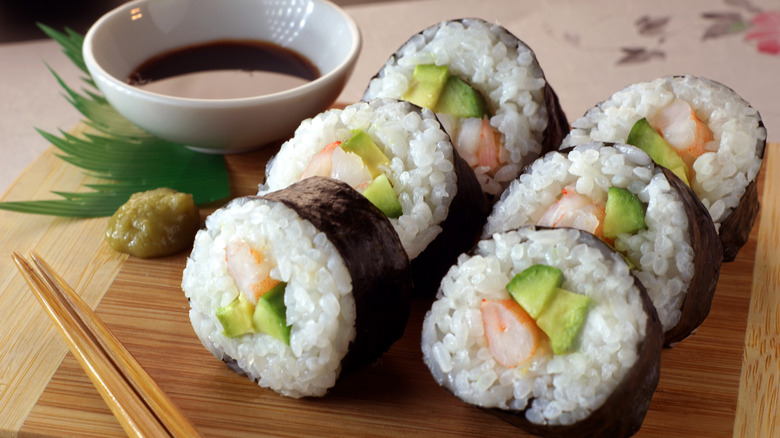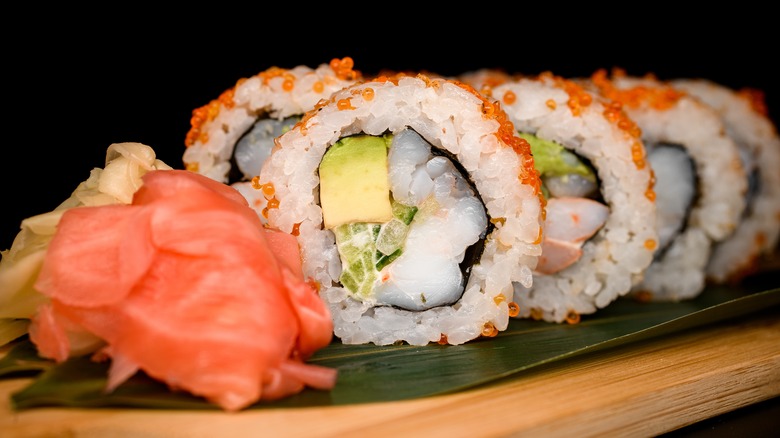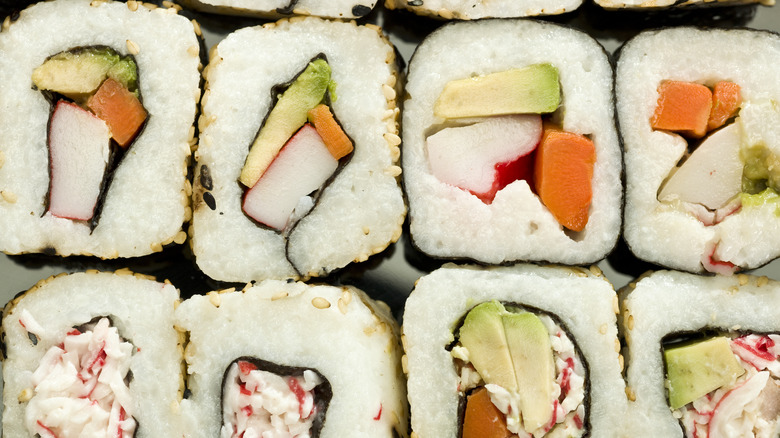The One Difference Between New York And California Sushi Rolls
If you're newer to sushi restaurants, you may glance down at the array of rolls (maki) on the menu and feel overwhelmed by all the variations. Luckily, there are a few common rolls that are said to have been created by Japanese chefs specifically for people in North America who were newcomers to sushi and perhaps shied away from uncooked fish. New York and California sushi rolls are two such sushi rolls that don't contain any raw fish. Though these rolls might seem strikingly similar at first glance, there is one key difference: the type of seafood included.
Both rolls contain cooked fish, cucumber, and avocado, but New York sushi rolls include shrimp as the protein, while California rolls are infamous for their inclusion of imitation crab meat. The precise preparation of the cooked fish can vary depending on the restaurant or sushi bar, but both rolls are generally good for those getting acquainted with sushi. When choosing between a New York and California roll, the main difference will come down to your fish preference as the cooked fish in either roll imparts its own signature flavor and texture.
Both sushi rolls have unique flavor and textural compositions
You might be thinking that the choice between shrimp and imitation crab can't make that much difference in these rolls, however, when it comes to ordering a New York vs. California roll, the type of seafood does impact the eating experience. With both sushi rolls, each bite provides a pleasant play of contrasting textures and flavors: the refreshing crunch of the cucumber, the buttery avocado, the subtle sweet acidity of the sushi rice, and the earthiness of the seaweed wrapper (nori).
In a New York roll, though, you'll get more of a bouncy bite from the cooked shrimp. The shrimp can be steamed or sauteed, and it is sometimes marinated or coated in soy sauce or teriyaki — though it's more common for the shellfish to be included without much extra seasoning. Some chefs even cook the shrimp tempura-style, adding a fried element and crisp to the mix.
A California roll, on the other hand, contains imitation crab meat, which, as the name implies, isn't really crab at all. It's actually the flesh of white fish like cod or tilapia, which has been condensed and formed into tube-like sticks or shreds with thickening ingredients, sugar, and flavorings. When used in a California roll, imitation crab meat (which can be included as is, or mixed with mayo to make crab salad) does taste crab-like and it is softer to the bite compared to the relative chewiness of the shrimp in a New York roll.
Variations on these rolls
In addition to the potential preparation variations for the cooked fish, both sushi rolls can be dressed in different ways before they make it to your plate. For example, due to the relative simplicity of each roll, it's pretty common for sushi restaurants to top both California and New York rolls with spicy mayo, sesame seeds, or other flavorful condiments and sauces. Both rolls are typically served with pickled ginger and wasabi for extra flavor and palette cleansing between bites.
While the one key difference between the rolls is the type of cooked fish, both are open to culinary interpretation. For instance, you might find a New York roll topped with masego (fish eggs) — though technically, that's a Boston roll. Or, you might find a California roll made extra rich with cream cheese (like a Philly roll). Either roll might include extra ingredients like fried onion. Either way, both New York and California sushi rolls are meant to be pretty straight-forward, prepared with cooked fish. If you're new to sushi, or just particularly enjoy these rolls and their ingredients, give each a try to determine your sushi preference. Or why choose, when you can have both?


